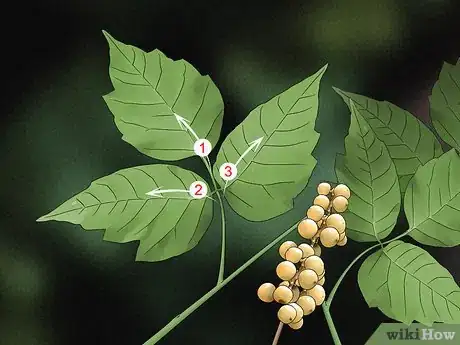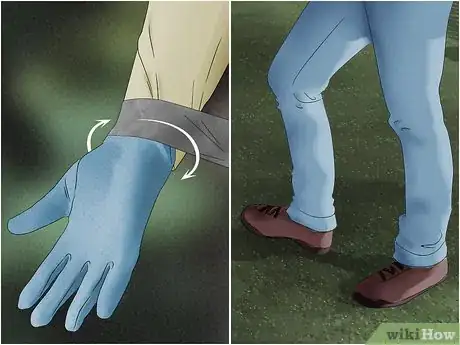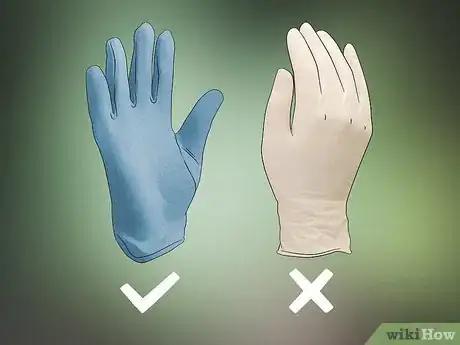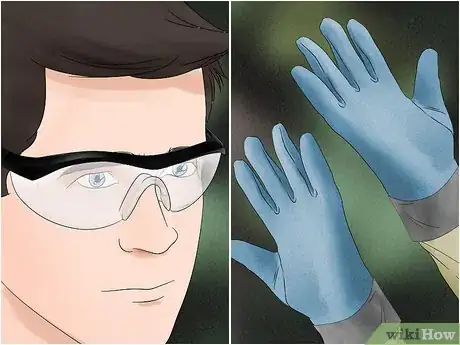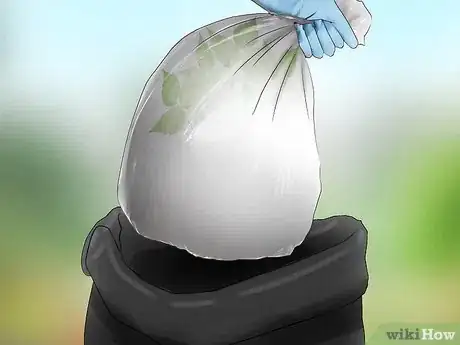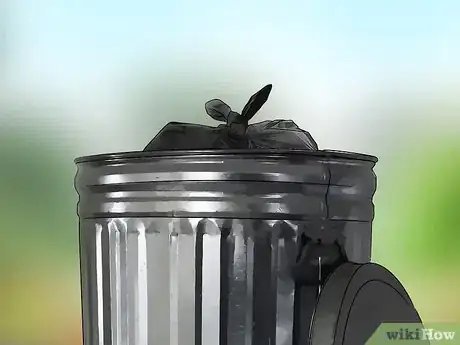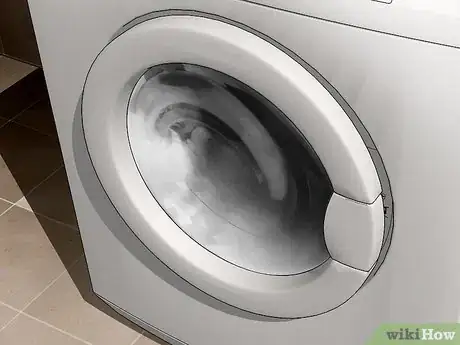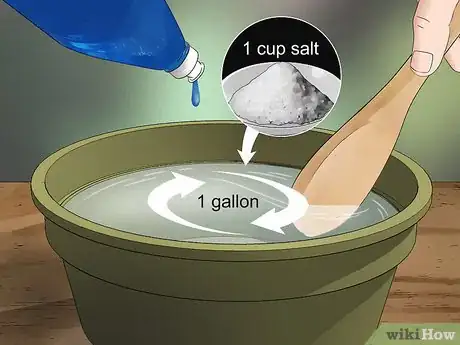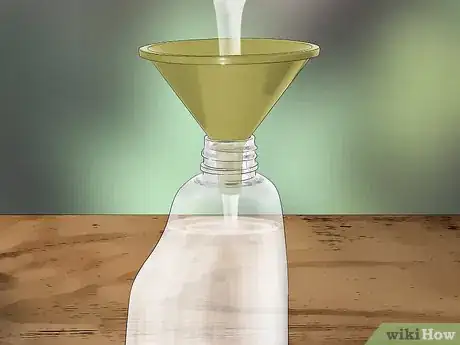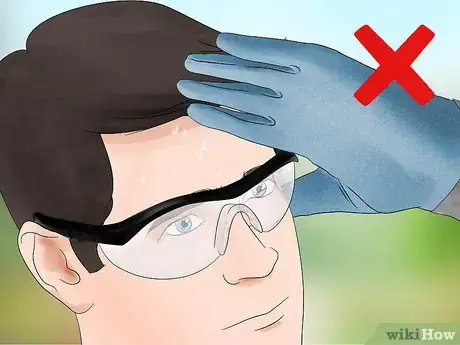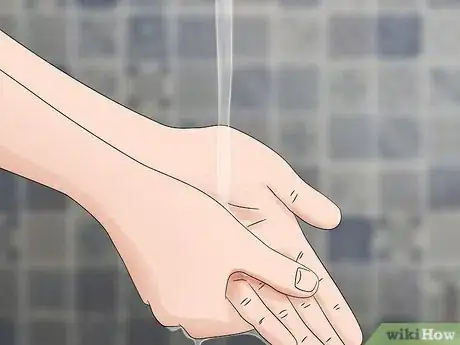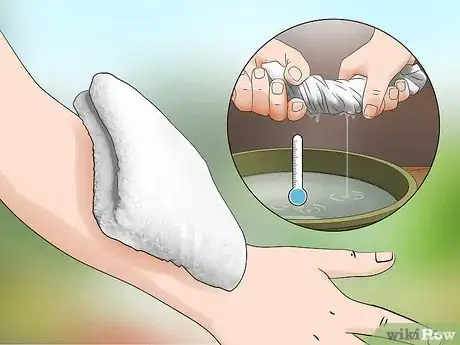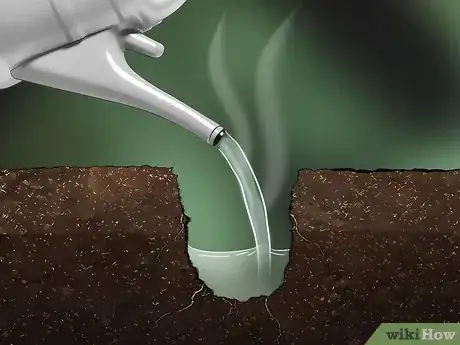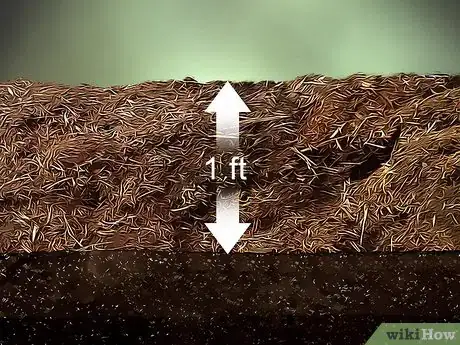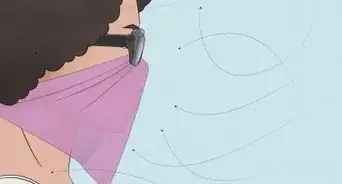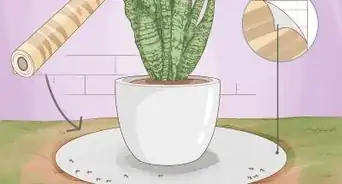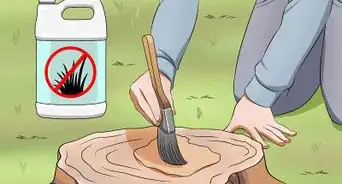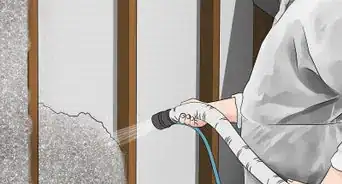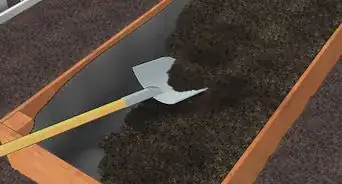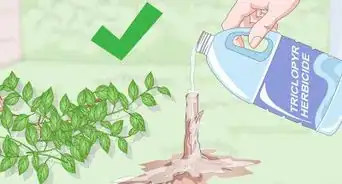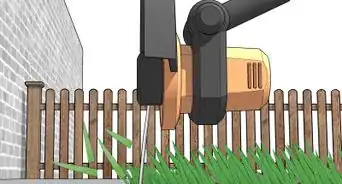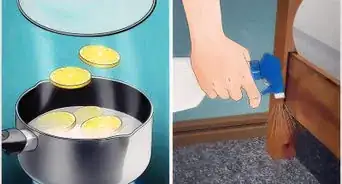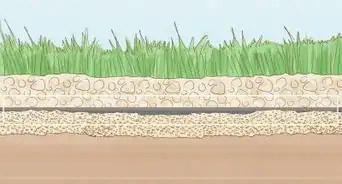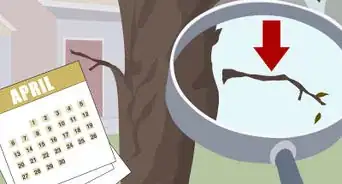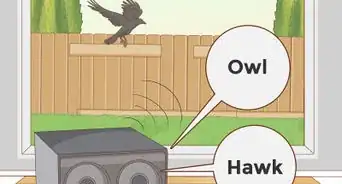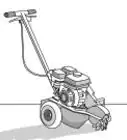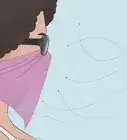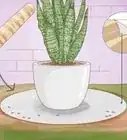This article was co-authored by Maggie Moran. Maggie Moran is a Professional Gardener in Pennsylvania.
There are 10 references cited in this article, which can be found at the bottom of the page.
This article has been viewed 54,922 times.
Poison ivy can be a pain to deal with! If you’re looking for a safe way to get rid of the pesky plant, try natural solutions like digging up the roots or spraying on a vinegar solution. Kill off any remaining roots with boiling water or a layer of sheet mulch. Remember to stay safe and covered while working with poison ivy, and never let it come into contact with your skin.
Steps
Identifying Poison Ivy and Protecting Yourself
-
1Identify poison ivy by its signature 3 leaves and pointed tips. Poison ivy plants have a compound leaf, made up of 3 leaflets. The center leaflet is slightly taller than the 2 on the sides, and the leaves’ color will change according to the season. The plant can grow as a vine or a bush, and may also have clusters of hard, white berry-like fruit.[1]
- The leaves will turn reddish in the spring, green in the summer, and yellow or orange in the fall.[2]
- Beyond those main characteristics, poison ivy plants can also vary slightly. For example, they may have smooth or jagged edges, and their texture can either look glossy or dull.
- When in doubt, avoid any plants that have the 3-leaf compound.
-
2Wear long sleeves and pants to keep your skin from touching the plant. Cover as much skin as possible by wearing full-coverage clothes as well as gloves with no holes. You may also want to duct tape the ends of your sleeves to your gloves and your pants to your socks, just in case.[3]
- You should also carry a garbage bag with you to collect all the parts of the poison ivy plant.
Advertisement -
3Wear thick work gloves while you handle the poison ivy. Choose a glove material like vinyl or leather for the best protection. You could also use a pair of cotton gardening gloves layered with plastic gloves for a disposable option. However, never wear latex gloves when working with poison ivy! Latex soaks up the plant oil, bringing it in contact with your skin.[4]
Digging Up the Plants
-
1Wear protective eyewear and sturdy gloves while you work. The digging method tends to be the most effective, but it requires direct contact with the plant, so take extra care to protect yourself! Wear work gloves, clothing with full coverage, and protective eyewear in case any sap sprays.
-
2Pull up the plants by hand with plastic shopping bags. To prevent contact as much as possible, use a plastic shopping bag as another layer of protection. Place the shopping bag over a plant, then lift it up to pull the plant out of the ground. Lift slowly to pull out as many roots as possible.[5]
- Lifting too quickly can tear the roots and leave them behind, leading to unwanted regrowth.
- To prevent the plant oils from spreading, use a new plastic bag for each plant.
- If you’re struggling to remove larger plants, use a shovel to dig up their roots first and then pull them out.
-
3Bag all of the leaves and stalks in a garbage bag. Be as careful as possible and avoid touching the outside of the garbage bag with the plant. Place the poison ivy directly into the main garbage bag with the shopping bag still wrapped around it. Continue doing this until all the plants are gone.[6]
-
4Dig about 8 in (20 cm) into the ground to remove any leftover roots. Use your shovel to dig up and remove any hidden root systems. Dig through the whole area where the plants were growing, all the way out to the edges. Be careful not to fling the dirt into any unaffected areas, since this could spread the problem. Place any leftover roots that you find in the garbage bag.[7]
-
5Tie off the garbage bag and dispose of it. While you’re still wearing your protective gear and full-coverage clothes, take your full garbage bag to a dump or a dumpster. Do not put it in your trash bins, burn it, or compost it, since these methods will only spread the plant’s harmful oils.
-
6Clean up and wash any materials that came in contact with the plants. Wash your clothes and gloves with your normal laundry detergent and the hottest water possible. Throw away your gloves if they’re disposable, or give them a good wash if they’re not. Rinse your shovel off with mineral spirits, along with any other gardening tools you may have used to remove the plants.
Using a Spray-on Solution
-
1Wear gloves and eye protection when spraying. To prevent the spray from getting in your eyes, make sure to wear a pair of safety goggles or glasses while you work. You should also wear sturdy gloves in case your hands come in contact with a poison ivy plant.[8]
-
2Mix up a water, salt, and dish soap solution in a 5 US gal (19 L) bucket. Pour in 1 gallon (3.79 L) of water, and then use a plastic or wooden stirring stick to stir in 1 c (240 mL) of salt until it dissolves. Stir in 1 US tbsp (15 mL) of dish soap and stir until the solution is completely combined.[9]
-
3Pour the mixture into a 32 fl oz (950 mL) spray bottle. Use a funnel or measuring cup to transfer the solution into a plastic spray bottle. Screw the top onto the bottle securely, then make sure the spray nozzle is in the “open” or “on” position.[10]
- Refill the bottle as needed during the spraying process.
-
4Spray the solution liberally over the poison ivy plants. Coat all of the leaves and stalks with the solution. Keep in mind that this solution will kill whatever plant it comes in contact with, so be careful not to spray it on surrounding plants.[11]
- Don’t spray the solution on a rainy day, since the rain will just wash it away.
-
5Wait 2 weeks and spray again if necessary. The mixture will need to time absorb into the plant and kill the root system. You may need to repeat this process multiple times to fully eradicate the poison ivy.[12]
Getting Rid of the Oils
-
1Dispose of the poison ivy plants in garbage bags. Never burn or compost the plants, which would only spread their inflammatory oils. To throw them away, always seal poison ivy up in closed garbage bags. Leave the bags out for garbage collection or drop them off at a dumpster.[13]
-
2Avoid touching your face while working with poison ivy. Irritating residues can easily transfer and stay on your gloves and other protective clothing. If you’ve been handling poison ivy plants, don’t touch your face, ears, nose, or mouth until you’ve had a chance to throw away your gloves and wash your hands thoroughly with soap and warm water.
-
3Wash your clothes and tools immediately after contact with poison ivy. Make sure to launder any clothing that you wore while working on the poison ivy in the hottest water possible. Wash a second time to ensure that all of the poison ivy oils are removed.[14] This may seem excessive, but it can save you a lot of discomfort and frustration later!
- Rinse your tools in mineral spirits to cleanse them properly.
-
4Wash your skin immediately if it comes into contact with poison ivy. The plant will transfer irritating oils to your skin on contact, leading to a lot of discomfort. Wash the area thoroughly with soap and warm water, then scrub under your nails and wash any clothes that may have also come in contact with the plant.[15]
- If you catch the contact quickly and wash within 1 hour, you can sometimes limit the rash.
-
5Calm the rash with medicated cream or a cold compress. If you do develop the stinging, itching red rash that comes with poison ivy oil, treat it immediately. Soothe the itching with a layer of calamine lotion, or make a cold compress by soaking a washcloth in cool water and wringing it out, then laying it over the affected skin.[16]
- You can also apply non-prescription hydrocortisone to the area or take an antihistamine pill to help with itching and swelling.
- Although trying to resist the urge to scratch can feel like torture, it’s important to avoid irritating the rash further. Scratching can cause an infection, so try to distract yourself and soothe the skin with a cool washcloth instead.
Preventing Regrowth
-
1Pour boiling water over the dug-up area to kill any hidden roots. Fill the largest pot you have with water and bring it to a boil. While it’s still hot, pour the water over the entire area you dug up. To protect yourself and any other plants closeby, pour slowly and try not to splash the hot water.[17]
- You may need to repeat the boiling water technique several times to kill all of the roots.
-
2Smother any new growth with a layer of sheet mulch. After you pull or spray the plants, spread a 1 foot (0.30 m) deep layer of compost, grass clippings, straw, or wood chips. Leave the sheet mulch on for a full season so it can function as a barrier, preventing any new poison ivy plants, while simultaneously rejuvenating the soil.[18]
- To add an even stronger barrier, place cardboard underneath the sheet mulch or a layer of plywood over top of the sheet mulch.
- For example, you could cover the affected area with several layers of cardboard, then top it with about 1 foot (0.30 m) of mulch.[19]
-
3Monitor the area during the next few weeks for any new offshoots. Check around the edges of the mulched area for any new growth. If you spot any offshoots, spray or dig them up immediately. Add more sheet mulch to the area to keep the plants from coming back. You'll know that the area is clear of poison ivy when you stop finding regrowth!
Expert Q&A
-
QuestionHow do you get rid of poison ivy naturally?
 Maggie MoranMaggie Moran is a Professional Gardener in Pennsylvania.
Maggie MoranMaggie Moran is a Professional Gardener in Pennsylvania.
Home & Garden Specialist Take 3 pounds of salt and mix it with 1 gallon of water, then add 1/4 cup worth of dish soap. Spray or pour the mixture on the poison ivy. This solution can kill other plants, so use caution.
Take 3 pounds of salt and mix it with 1 gallon of water, then add 1/4 cup worth of dish soap. Spray or pour the mixture on the poison ivy. This solution can kill other plants, so use caution. -
QuestionHow long does it take for poison ivy to heal when treated?
 Maggie MoranMaggie Moran is a Professional Gardener in Pennsylvania.
Maggie MoranMaggie Moran is a Professional Gardener in Pennsylvania.
Home & Garden Specialist The poison will go away in between 1-3 weeks. In about a week, the blisters will dry up, and the rash begins to fade shortly after.
The poison will go away in between 1-3 weeks. In about a week, the blisters will dry up, and the rash begins to fade shortly after. -
QuestionWhat can I do if poison ivy is growing around my home?
 Community AnswerYou can put on garden gloves, grab the plant near the base and pull slowly to remove all traces. Put the plant into a wheelbarrow, repeat with on all plants and then discard them into the garbage.
Community AnswerYou can put on garden gloves, grab the plant near the base and pull slowly to remove all traces. Put the plant into a wheelbarrow, repeat with on all plants and then discard them into the garbage.
Things You’ll Need
Digging Up the Plants
- Sturdy gloves
- Protective eyewear
- Plastic shopping bags
- Garbage bag
- Shovel
- Laundry detergent
- Mineral spirits
Using a Spray-on Solution
- Sturdy gloves
- Eye protection
- A 5 US gal (19 L) bucket.
- 1 gallon (3.79 L) of water
- A plastic or wooden stirring stick
- 1 c (240 mL) of salt
- 1 US tbsp (15 mL) of dish soap
- 32 fl oz (950 mL) spray bottle
- Funnel or measuring up
Getting Rid of the Oils
- Garbage bag
- Soap and water
- Mineral spirits
- Medicated cream
- Cool compress
Preventing Regrowth
- Boiling water
- Sheet mulch (compost, grass clippings, straw, or wood chips)
- Cardboard or plywood
Warnings
- Do not burn poison ivy vines. The oils last long after the plants have died and, the smoke can inflame your lungs and nasal passages.⧼thumbs_response⧽
- Never let the poison ivy come into contact with your skin. Wear long sleeves, long pants, and gloves to keep your skin covered.⧼thumbs_response⧽
- If the rash appears near your eyes or covers a large part of your body, contact your doctor.⧼thumbs_response⧽
- If the rash causes a severe reaction, call 911.⧼thumbs_response⧽
References
- ↑ https://www.amnh.org/learn-teach/curriculum-collections/biodiversity-counts/plant-identification/tips-to-identify-poison-ivy
- ↑ https://www.webmd.com/allergies/treating-poison-ivy#1
- ↑ https://www.mnn.com/your-home/organic-farming-gardening/stories/what-is-the-best-way-to-get-rid-of-poison-ivy
- ↑ http://www.poison-ivy.org/control
- ↑ http://www.chicagotribune.com/lifestyles/home/ct-sun-0702-garden-morton-20170628-story.html
- ↑ http://www.chicagotribune.com/lifestyles/home/ct-sun-0702-garden-morton-20170628-story.html
- ↑ https://www.mnn.com/your-home/organic-farming-gardening/stories/what-is-the-best-way-to-get-rid-of-poison-ivy
- ↑ http://www.poison-ivy.org/control
- ↑ http://www.hgtv.com/outdoors/flowers-and-plants/how-to-kill-poison-ivy
- ↑ http://www.hgtv.com/outdoors/flowers-and-plants/how-to-kill-poison-ivy
- ↑ http://mikesbackyardnursery.com/2014/03/what-kills-poison-ivy/
- ↑ http://mikesbackyardnursery.com/2014/03/what-kills-poison-ivy/
- ↑ https://www.mnn.com/your-home/organic-farming-gardening/stories/what-is-the-best-way-to-get-rid-of-poison-ivy
- ↑ https://www.mnn.com/your-home/organic-farming-gardening/stories/what-is-the-best-way-to-get-rid-of-poison-ivy
- ↑ https://www.webmd.com/allergies/treating-poison-ivy#1
- ↑ https://www.aad.org/media/news-releases/treating-poison-ivy-ease-the-itch-with-tips-from-dermatologists
- ↑ http://www.hobbyfarms.com/6-natural-ways-to-kill-poison-ivy/
- ↑ https://www.tenthacrefarm.com/2014/07/how-to-kill-poison-ivy/
- ↑ https://www.tenthacrefarm.com/2014/07/how-to-kill-poison-ivy/
About This Article
Poison ivy is easily identifiable by its leaves, made up of 3 smaller, pointy leaflets. To kill poison ivy naturally, make sure you wear thick clothing, eyewear, and work gloves to protect yourself. Place plastic shopping bags over the plants and pull them out of the ground. Once you’ve pulled out all of the plants, dig about 8 inches down around the plants and pull out any leftover roots. When you’ve gotten rid of all the roots, pour boiling water over the soil to kill any hidden roots. Then, spread a layer of mulch, like compost, wood chips, or straw, to prevent any new poison ivy shoots growing through. Remember to wash your clothes with hot water and detergent to get rid of any residue from the poison ivy. For more tips from our Gardening co-author, including how to make a spray-on solution to kill poison ivy plants, read on!
